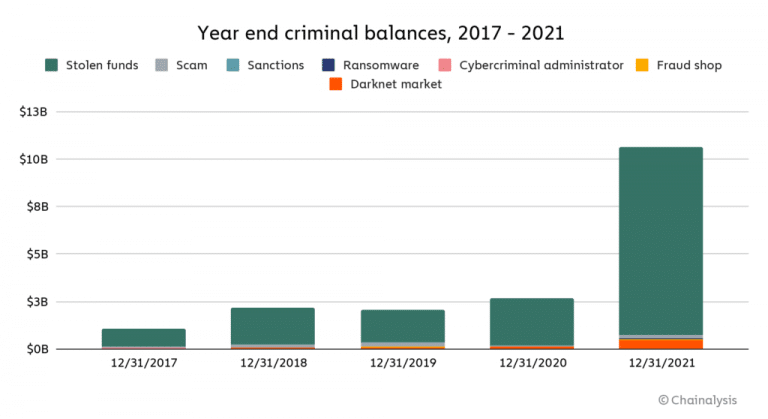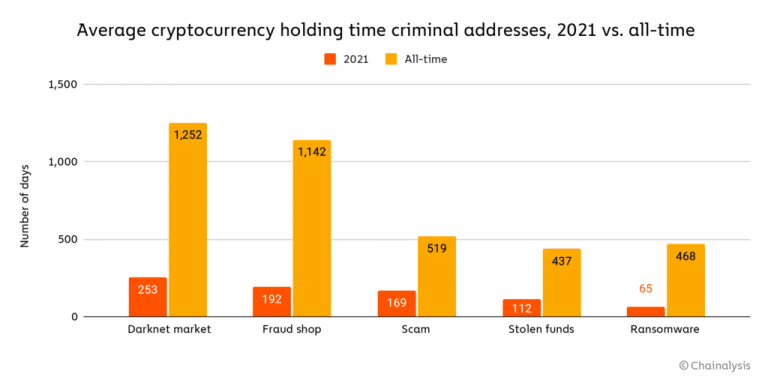The number of cryptocurrencies held by criminals increased in 2021, according to a new report excerpt published by analytics site Chainalysis. And it’s theft that still overwhelmingly dominates illicit practices. Zoom in on the habits of crypto-criminals.
Crypto-assets are mostly stolen
The excerpt, published on the Chainalysis blog, shows one thing: the general public’s renewed interest in cryptocurrencies has logically translated into rising crime in 2021. The amount of illegal cryptos held on visible addresses thus rose from $3 billion in 2020 to $11 billion the following year.
Recall that while some interpret this as evidence that cryptocurrencies are associated with crime, the trend will be seen more as a sign of the gradual democratisation of these assets. As a reminder, cryptocurrencies linked to illicit practices accounted for only 0.15% of total transaction volume during 2021.
The data that jumps out, however, is how dominant stolen assets are when compared to other methods of obtaining them. Chainalysis distinguishes 7 categories of illicit practices: crypto theft, scams, sanctions, ransomware, administration by cybercriminals, fake online shops, and Darknet markets.
In 2021, theft accounted for the vast majority of illicitly held cryptos:

Breakdown of illicitly held cryptocurrencies (Source: Chainalysis)
In total, stolen assets dominate at 93% of all illicitly held cryptocurrencies. The second major category is Darknet assets, which also show a breakthrough, but are “only” worth $448 million.
Scams follow ($192 million), then fake shops ($66 million) and ransomware ($30 million).
Crypto-criminals’ wallets
Chainalysis further notes that these illicitly held funds have varied greatly in volume over the course of 2021. In July, it was $6.6 billion, compared to $14.8 billion in October.
What this means, of course, is that crypto-criminals have a vested interest in liquidating their stolen assets quickly, so that they can profit from their larceny without being prosecuted. This is further confirmed by another graph: stolen funds are among those that are liquidated the fastest, while Darknet funds tend to be kept:

Average holding time of crypto-assets by criminal addresses (Source: Chainalysis)
And the trend is accelerating, according to the report:
“What really stands out is how much retention times have been reduced overall. The average holding time for 2021 is 75% shorter than for the total years, for all categories. “
The acceleration of crypto practices as a whole has therefore also resulted in greater fluidity of funds linked to criminal acts.
Crime whales and their assets
The Chainalysis report also looks at criminal whales, which are wallets holding more than $1 million in cryptocurrencies. It notes that funds held by whales are calculated based on private wallets, while funds held by criminals in general are calculated by addresses reported as illicit, hence the difference in overall amount.
Chainalysis counts just over 4,000 whales holding illicit cryptos, which between them would amount to $25 billion. However, they would only represent 3.7% of all cryptocurrency whales.
The report also notes more variety in payments from illicit addresses, with amounts that are either very small or very large. The different fund categories are also more spread out:

Categories of illegal funds received by whales (Source: Chainalysis)
Stolen assets thus account for only 24% of cryptos held, compared to 37% for funds from the Darknet and 32% for scams. The report also notes that it would appear that a good portion of such whales would be located in time zones corresponding to Russia, including Moscow and St Petersburg. This supports a previous Chainalysis report, which indicated that 73% of ransomware revenue would be linked to Russia.
